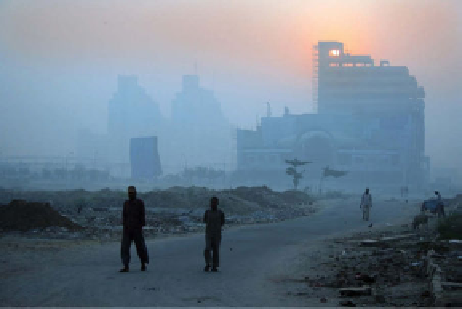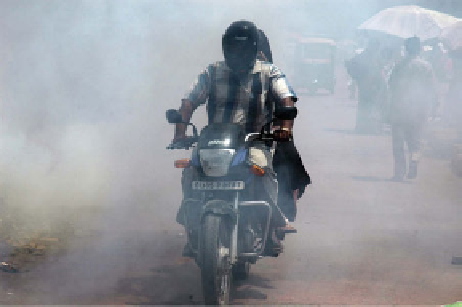Geoscience Reference
In-Depth Information
(a)
(b)
Figure 8.9.
(a) Motorcycle emitting smoke on a street in Calcutta, India, on April 24, 2007;
C
Samrat35/Dreamstime.com. (b) New Delhi winter morning through air pollution haze.
Digitalfestival/Dreamstime.com.
C
300 million in 1947 to 1.2 billion in 2011, has strained
resources and increased pollution (Figure 8.9). In 2007,
about 40 percent of India's energy was from coal burn-
ing, and 27 percent was from the burning of
solid bio-
fuels
(e.g., wood, grass, agricultural waste, dung). Solid
biofuels are burned on a large scale within individual
homes for heating and cooking. Although India had
only 13 million cars in 2008, the number is increas-
ing rapidly. In addition, about 10 percent of households
ownamotorcycle. The combination of coal, solid bio-
fuel, and transportation fuel combustion has resulted
in some of the world's most intense air pollution, not
only in major cities such as New Delhi and Calcutta,
butalso on a continental scale. Such emissions have
contributed, along with pollution from China, to the
Asian Brown Cloud
,aphenomenon that can be seen
by satellite (Figure 8.10; Ramanathan et al., 2001).
From the 1880s until recently, Calcutta, near the coal
fields of West Bengal, was the most polluted city in
India. Calcutta built iron, steel, glass, jute, chemical,
and paper industries powered by coal combustion. By
the 1920s, smokestacks from 2,500 coal-fired steam
boilers covered Calcutta's landscape (McNeill, 2000).
Early smoke control was facilitated by the willingness
of the authoritarian colonial government of India to
clamp down on smoke emissions. Regulatory controls
in Calcutta reduced smoke from the 1910s to the 1950s,
at which time smoke emissions started to increase again.
In the 1980s, an increase in the number of vehicles
exacerbated pollution problems. Today, New Delhi and
Calcutta are the most polluted cities in India.
In 1976, India passed an amendment to its consti-
tution allowing the government to intervene to protect
public health, forests, and wildlife. This amendment
wasineffective because another clause in the constitu-
tion stated that the amendment was not enforceable in
court.
In 1981, India passed the
Air (Prevention and Con-
trol of Pollution) Act
,afirst effort to control and
abate air pollution. In 1984, an accidental release of
methyl isocyanate from a pesticide manufacturing plant
in
Bhopal
,India, killed 4,000 people and injured more
than 200,000 others. As a result,
The Environment
(Protection) Act of 1986
was passed, giving the Min-
istry of Environment and Forests responsibility over
controlling emissions from all sources. A series of laws
and rules were subsequently enacted that enforced the
siting, transportation, emissions, and storage of haz-
ardous waste. The first emission standards for vehicles
in India were for idling vehicles and became effec-
tive in 1989. Motor vehicle emission standards were
set for gasoline vehicles in 1991 and diesel vehicles in
1992. By 2000, India adopted Euro 1 passenger vehicle
emission standards (Table 8.5), which were tightened
to Euro 4 standards by 2010. In 2000, India set rules
on the production and consumption of ozone-depleting
substances.
8.2.10. China
China is the world's most populous country, with
more than 1.3 billion inhabitants in 2011. Two major



Search WWH ::

Custom Search